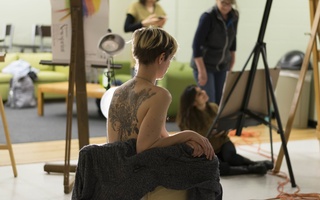{shortcode-078661a825a95eb67059aa46da839350865e0dcd}For centuries, the medium of drawing, as opposed to the so-called “finished” visual arts—namely, painting and sculpture—was primarily conceived of as a preparatory and private process, to be undertaken within the confines of the artist’s studio and left unviewed by the general public. The products of the practice have now moved beyond the artist’s personal sketchbook and into the third floor of Harvard Art Museums.
“Drawing: The Invention of a Modern Medium,” on display in the Harvard Art Museums’ University Teaching and Research Galleries from Jan. 21 through May 7, 2017, seeks to make visible the transformative historical moment in which drawing emerged as an independently recognized practice. The show primarily features works from the 18th and 19th centuries. But how exactly does “Drawing” take the age-old private practice and make it new—and, as its title suggests, “modern”?
Professor Ewa Lajer-Burcharth from the Department of History of Art and Architecture—who co-curated the exhibition with Elizabeth Rudy, Carl A. Weyerhaeuser Associate Curator of Prints—believes that a dramatic shift in the conditions necessary for art production helped play a role in increasing the visibility of drawing. The result was a surge of interest in drawing as an independent means of expression, an elevation of its status to an object of aesthetic reflection, and a newfound desire to display drawings as finished products on museum walls. “The argument [the exhibition] makes is that drawing becomes modern in the 18th century, and the reason for it is that it leaves the privacy of the artist’s studio and enters the social sphere,” said Lajer-Burcharth. “Before this historical moment, drawing resided in portfolios. Now, it was framed, put under glass, and exhibited under the Salon.”
Despite its emphasis on historical context, the exhibition interestingly does not adopt a traditional chronological or oeuvre-based arrangement. Instead, works are separated into sections titled Medium, Discourse, and Object, each of which brings a specific set of discourse and theoretical questions to the viewing of drawing. Each section contains subsections with two to three selected drawings. These subsections allow readers to hone in on a specific thematic concern within the larger field. A subsection under “Discourse,” for instance, prompts viewers to consider the relationship between the immediacy of drawing and representations and indices of violence; another, categorized under “Medium,” invites consideration of the formal properties of line and its function as both temporal marker and symbol of the “artist’s touch.” “What we wanted to do with the exhibition [was to allow] one to construct a historical argument without applying a historically linear structure of display,” said Lajer-Burcharth.
It’s an intellectual process with which Harvard students were heavily involved. Twenty students enrolled in two seminars co-taught by Lajer-Burcharth and Rudy, offered in the Fall 2015 and Spring 2016 semesters. In the first course, titled Drawing: Object, Medium, Discourse, graduate students actively discussed the selection of works with independent research. Students produced new scholarship in the form of essays on their six selected subsections, all of which are included in the exhibition catalogue.
The second course, Drawing on the Exhibition, offered primarily undergraduate students the opportunity to think through the physical act of display. Students were responsible for developing gallery labels for each artwork and other short written content. Another product of the group’s work on the exhibition content was the development of a digital tool. The tool includes audio commentary on specific artworks and a kind of visual tour through each subsection of the gallery. “The digital tool wasn’t something we’d planned from the outset…. [but] after working with the students over the course of the semester, we realized how excited they were about the drawings and how much they had to say, so we decided the digital tool would serve as a platform to showcase the museum’s fantastic collection,” said Rudy.
In an exhibition as heterogenous and complex as “Drawing,” perhaps the grounding element is student involvement. The hybrid exhibition is an extended, collaborative project that pushes the boundaries between the purely curatorial and the purely academic. “There really hasn’t been a project quite like this,” said Rudy. “The exhibition and the catalog came out of working with students, developed in tandem with them. And we’re extremely pleased with the result.”
—Staff writer Qianqian Yang can be reached at qianqian.yang@thecrimson.com
Read more in Arts
From the Vaults: ‘In Praise of Love’Recommended Articles
-
Exhibition of Drawings at FoggWork done during the year in freehand drawing and design courses in the Fine Arts Department will be put on
-
Exhibition of Drawings OpenAn exhibition of drawings made by students in the School of Domestic Architecture and Landscape Architecture for Women is now
-
Lampy Opens Its DoorsAll men, including those from 1920, wishing to try for the writing and drawing department of the Lampoon should report
-
MFA ‘Drawing’ Exhibit Is Far Too BroadConfronted with a smorgasbord of “drawings,” one can’t help but wish that the scope of “Drawing: A Broader Definition” was
-
 Figure Drawing Class Evokes Empathy
Figure Drawing Class Evokes Empathy













